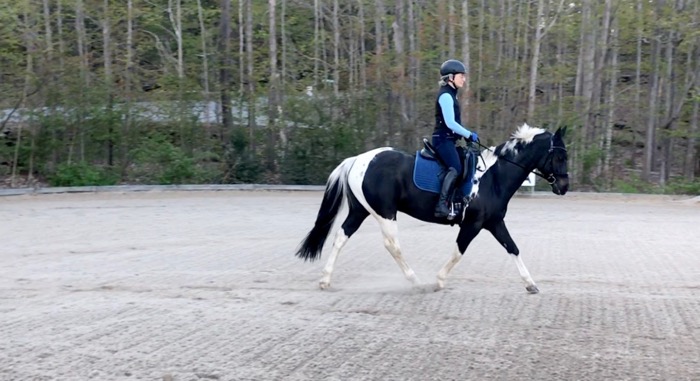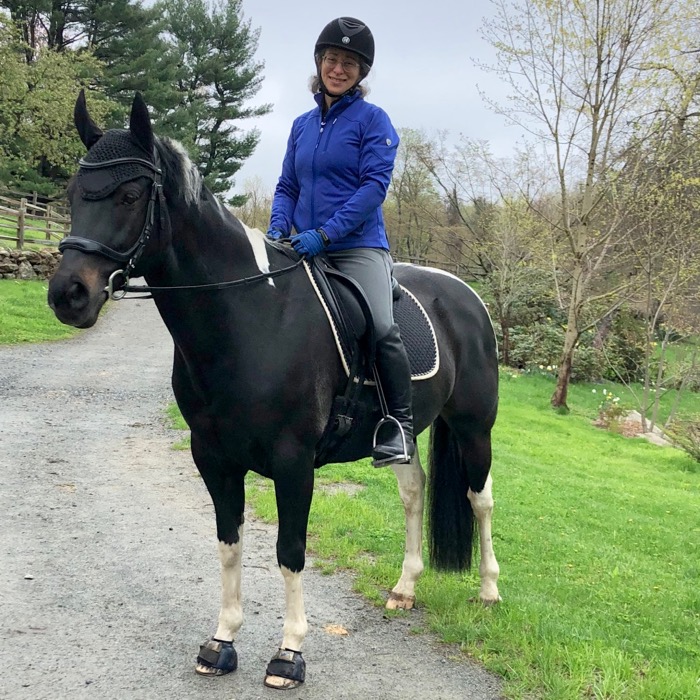This might look like a disobedient buck, but it’s not. When I watched the video frame-by-frame I could see that Tonka hopped behind for a stride. Like he had a glitch that needed adjustment.
This also might look like disobedience. Dressage riders don’t like open mouths. It’s how the horse evades the bit. Often, a noseband is cranked tightly around the jaw or over the nostrils to keep the mouth shut. I don’t use that tack because Tonka’s open mouth is communication to me. When Tonka is unhappy, he juts out his under neck, sinks his back, and opens his mouth. I’m not always sure what initiates this behavior. It might be that I’m not riding as tactfully as I should, perhaps my hands are unsteady or braced in a way that causes discomfort. Or, maybe, he’s got a twinge in his body and he hurts. I make adjustments and figure it out.

Tonka has spent half a year moving in a certain way to avoid his aching sacroiliac joint (and maybe the arthritis in his left hock, too.) He’s built muscles in the wrong places, and he’s gotten into patterns of going that I need to rework in order to get him traveling comfortably and soundly. It’s the equivalent of physical therapy. If you’ve ever been to PT, you know that it’s not easy. I have to insist that Tonka move in ways outside of his comfort zone. But I also have to listen. Pushing my horse through pain isn’t going to accomplish anything. The trick is to find the good strides, and expand on them. Tonka enjoys them as much as I do, and he’ll do more and more of them as he gets stronger.
Here we’re back in balance.

We’d been putting in the work, but Tonka wasn’t making the progress that my veterinarian had expected. I asked to have some blood work done. Was Tonka low in vitamin E? Although it’s rare to see clinical diseases caused by a vitamin E deficiency, you sometimes see a lack of recovery from exercise and general discomfort. The lab report showed that Tonka’s vitamin E level was low. Horses can’t make their own vitamin E, they have to ingest it. It naturally occurs in green grass, which is seasonal, and which Tonka doesn’t get a lot of. Although his pelleted grain has vitamin E in it, the test made it clear that Tonka needed more. I immediately put him on a supplement.
In less than two weeks, I noticed a marked change. Tonka seemed generally more cheerful. He was enjoying his grooming sessions more, and he seemed more eager under saddle.

We’ve been having some super rides in the ring, too. There’s still the hard work of strengthening Tonka’s back muscles, reducing his under neck, and building his topline. But, it’s happening. Tonka is enthusiastic about upward transitions. He’s ready to go.
Not all horses are as sensitive to low levels of vitamin E. This one, though, will be on supplements for life.



Good for you to discover this, Terry!
It’s one more piece to the puzzle – but an important one! I also had Tonka tested for Lyme. Fortunately, that was negative.
This was so helpful for me to read. My horse has similar physical challenges, and I never thought of his training as physically therapeutic. Yeah, we all try to work left and right, up hills and such to help with balanced muscle development, but I just never thought about schooling as a means to a therapeutic end. Your post is also the nudge I needed to check in on my horse’s nutritional profile. Thank you for sharing!
Glad it was helpful, Helena! I’ve been to enough PT in my life to know that you have to put up with the aches to make progress, but also that if a PT pushes you too hard, that it can be counterproductive. Tonka was putting in the effort, but there was something blocking the progress. I hope the vitamin E is the key to further improvement. Let me know if you do a blood test on your horse and what the results are.
Last year we noticed changes in my daughters 20 year old POA. We were worried he might be developing Cushings, so we had some blood work done and found that he was Vitamin E and selenium deficient. Thankfully no Cushings though! Got him on supplements and noticed an improvement in him almost immediately. We are just getting ready to get his test done this year. So happy you are getting this information out. Not too many people seem to be aware that this is a thing.
I had Tonka tested for selenium, too. Here in the northeast, we’re rarely low in selenium. That’s a mineral that is detrimental if they get too much or too little. Doing blood work is the right course before supplementing. It’s great that you did that, and that the results from treatment were obvious. So often it’s not with horses! Isn’t clarity great? 🙂
You’ve given me pause for thought. Lance’s pasture time is very limited due to his metabolic disease; I am going to look into supplemental Vitamin E!
It might be a small thing that makes everything else that you’re doing more effective. Let me know!